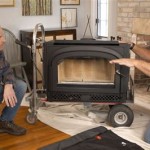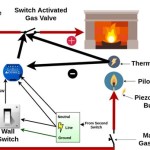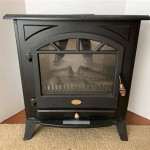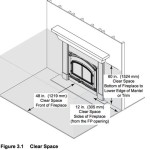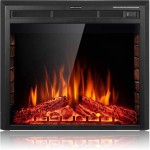Gas Log Fireplace Mantels: A Comprehensive Guide
A gas log fireplace offers the ambiance of a traditional wood-burning fireplace without the associated mess and extensive maintenance. One of the key components that completes the aesthetic of a gas log fireplace is the mantel. A mantel provides a focal point, enhances the style of the room, and can serve as a functional shelf for displaying decorative items. Selecting the right mantel for a gas log fireplace requires careful consideration of several factors, including material, style, dimensions, and safety regulations.
Gas log fireplaces operate by burning natural gas or propane to simulate the appearance of a wood fire. Unlike wood-burning fireplaces, they do not produce significant amounts of ash, creosote, or smoke, making them a cleaner and more convenient option. However, they still generate heat, and it is crucial to ensure that the mantel is appropriately installed to prevent any fire hazards. The installation process typically involves adhering to specific clearance requirements and utilizing non-combustible materials in proximity to the firebox opening.
Understanding Fireplace Mantel Materials
The choice of material for a gas log fireplace mantel is paramount, not only for aesthetic reasons but also for safety purposes. Common materials include wood, stone, and composite materials, each with its own set of characteristics and considerations.
Wood Mantels: Wood mantels are a popular choice due to their natural beauty and versatility. They can be crafted from various types of wood, such as pine, oak, maple, and cherry, each offering a distinct grain pattern and color. Wood mantels can be stained, painted, or left natural to complement the surrounding décor. However, wood is a combustible material and must be installed according to specific clearance guidelines to prevent ignition. The National Fire Protection Association (NFPA) provides recommendations for safe distances between wood mantels and the firebox opening. Typically, a non-combustible material, such as brick or stone, should be used as a buffer between the firebox and the wood mantel. This buffer, often referred to as a "legs" or "risers," helps to dissipate heat and protect the wood from direct exposure to flames.
Stone Mantels: Stone mantels offer a timeless and elegant look, and they are inherently non-combustible. Stone options include natural stone, such as granite, marble, limestone, and slate, as well as manufactured stone. Natural stone mantels can be quite heavy, requiring reinforced supports for installation. Manufactured stone mantels are often lighter and easier to install, offering a similar appearance to natural stone at a lower cost. Stone mantels are an excellent choice for gas log fireplaces because they can withstand high temperatures without warping or igniting. They also provide a durable and long-lasting focal point for the room.
Composite Mantels: Composite mantels are made from a combination of materials, such as wood, resin, and stone dust. They are designed to mimic the appearance of wood or stone while offering improved fire resistance and durability. Composite mantels are typically lighter than natural stone mantels, making them easier to install. They are also less susceptible to warping or cracking than wood mantels. The fire resistance of composite mantels varies depending on the specific composition of the material. It is important to check the manufacturer's specifications to ensure that the composite mantel meets the necessary safety standards for use with a gas log fireplace.
Choosing the Right Mantel Style and Dimensions
Selecting the appropriate style and dimensions for a gas log fireplace mantel is essential for achieving a cohesive and visually appealing design. The style of the mantel should complement the overall architectural style of the room, while the dimensions should be proportional to the size of the fireplace and the surrounding space.
Mantel Styles: Mantel styles range from traditional to contemporary, and the choice depends on personal preferences and the existing décor. Traditional mantels often feature ornate carvings, intricate detailing, and classic moldings. They are typically made from wood or stone and are designed to evoke a sense of elegance and formality. Contemporary mantels, on the other hand, tend to be more minimalist and streamlined, with clean lines and simple shapes. They may be made from wood, stone, or metal and are designed to create a modern and sophisticated look. Transitional mantels blend elements of both traditional and contemporary styles, offering a balance between classic and modern design. They often feature subtle detailing and neutral colors, making them a versatile choice for various décor styles.
Mantel Dimensions: The dimensions of the mantel should be proportional to the size of the fireplace opening and the surrounding wall. A mantel that is too small will look insignificant, while a mantel that is too large will overwhelm the space. A general rule of thumb is that the mantel should be wider than the firebox opening by at least 6 to 12 inches on each side. The height of the mantel should also be considered, ensuring that it is not too high or too low in relation to the firebox. The depth of the mantel shelf should be sufficient to accommodate decorative items without being too bulky. It is important to measure the fireplace opening and the surrounding wall accurately before selecting a mantel to ensure a proper fit.
For corner fireplaces, the mantel design will differ significantly. Typically, corner fireplace mantels are constructed to wrap around the corner, creating a seamless focal point. These mantels often require custom designs to properly fit the unique angles of the corner fireplace.
Safety Regulations and Installation Considerations
The installation of a gas log fireplace mantel must adhere to specific safety regulations to prevent fire hazards and ensure the safe operation of the fireplace. These regulations typically specify minimum clearance distances between the mantel and the firebox opening, depending on the material used for the mantel. The installation process should be performed by a qualified professional who is familiar with the applicable building codes and safety standards.
Clearance Requirements: Clearance requirements dictate the minimum distance that combustible materials, such as wood mantels, must be kept away from the firebox opening. These requirements are designed to prevent the wood from overheating and potentially igniting. The NFPA provides detailed guidelines for clearance distances, which vary depending on the size and type of fireplace. In general, the higher the mantel is above the firebox opening, the less clearance is required. A non-combustible barrier, such as brick or stone, can be used to reduce the clearance distance if necessary. It is crucial to consult the manufacturer's instructions for the gas log fireplace and the mantel to ensure that the installation meets the required safety standards.
Professional Installation: The installation of a gas log fireplace mantel is best left to a qualified professional. A professional installer will have the necessary knowledge and experience to ensure that the installation is performed safely and correctly. They will be familiar with the applicable building codes and safety standards and will be able to address any potential issues that may arise during the installation process. A professional installer will also be able to properly secure the mantel to the wall, ensuring that it is stable and can support the weight of any decorative items placed on the shelf. Attempting to install a mantel without the proper knowledge and experience can be dangerous and may result in a fire hazard.
Ventilation and Gas Line Considerations: When installing a gas log fireplace and a mantel, it is also important to consider ventilation and gas line safety. The gas log fireplace must be properly vented to prevent the buildup of carbon monoxide, a colorless and odorless gas that can be deadly. The venting system should be inspected regularly to ensure that it is functioning properly. The gas line should also be inspected for leaks, and any leaks should be repaired immediately. A qualified professional should perform these inspections and repairs to ensure safety.
In addition to adhering to safety regulations, it is important to consider the aesthetic impact of the mantel on the overall design of the room. The mantel should complement the existing décor and enhance the visual appeal of the fireplace. Thoughtful planning and careful execution are essential for creating a beautiful and safe gas log fireplace with a well-chosen mantel.
The height of the ceiling in the room can also influence the perceived size of the mantel. In rooms with high ceilings, a larger, more substantial mantel may be appropriate, while in rooms with lower ceilings, a smaller, more streamlined mantel may be a better choice.
Maintaining the cleanliness of the mantel is also important. Regular dusting and cleaning will help to keep the mantel looking its best and prevent the buildup of dirt and grime. The type of cleaning products used will depend on the material of the mantel. Wood mantels should be cleaned with a gentle wood cleaner, while stone mantels can be cleaned with a mild soap and water solution.
Finally, consider the long-term maintenance of the mantel. Wood mantels may require periodic refinishing or staining to maintain their appearance, while stone mantels are generally more durable and require less maintenance. Choosing a material that is easy to maintain will help to ensure that the mantel looks its best for many years to come.

Marquess Keenan Mantels Mm Gas Fireplace Mantel Toronto Best

Types Of Fireplaces And Mantels The Home Depot

Fireplace Mantels Mantel Shelves Custom Surrounds And More Direct

Mantels N Gas Log Fire

Imperial Keenan Mantels Mi Gas Fireplace Mantel Toronto Best

Fireplace S In Tenneessee Gas Logs More Admiral Propane
Debating A Modern Or Traditional Fireplace Heat Glo

How To Select And Size Your Fireplace Mantel Water S Edge Woods Custom Wood

Fireplace Mantels Mantel Shelves Custom Surrounds And More Direct

Wood Mantel And Surround For Corner Gas Fireplace
Related Posts

